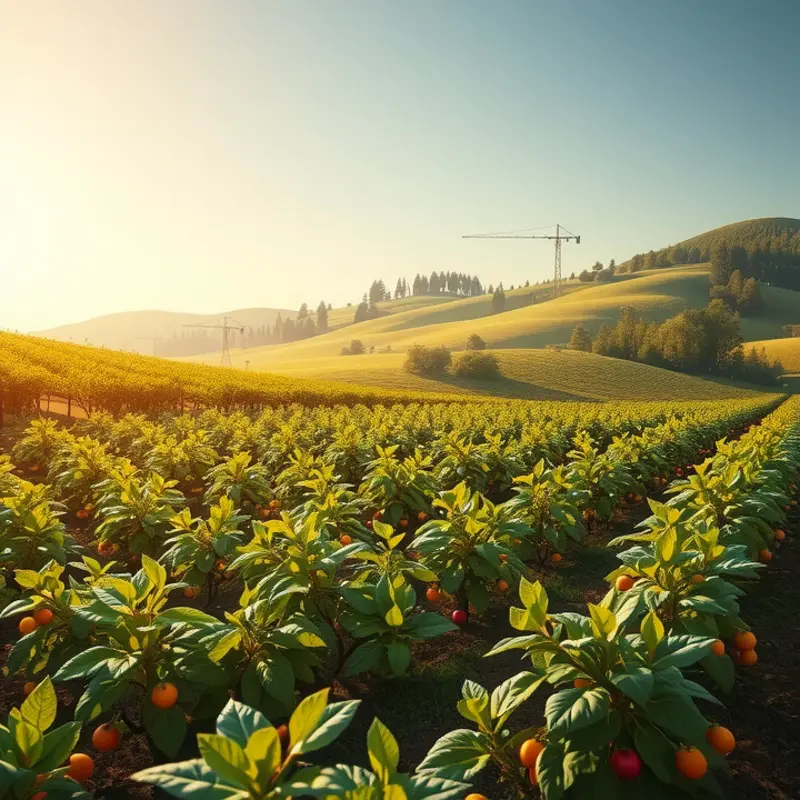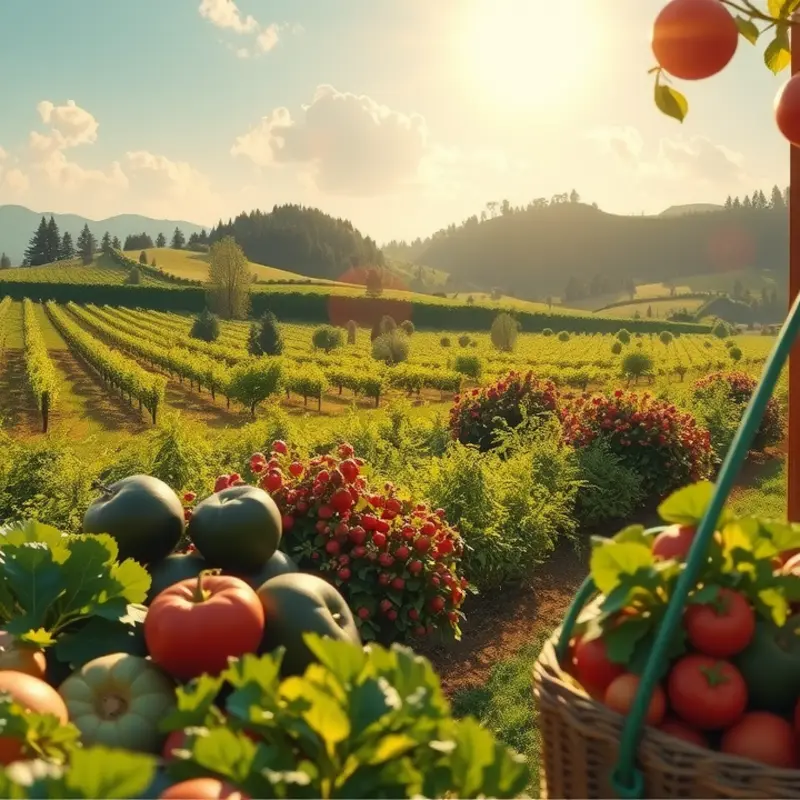Sustainable farming practices are reshaping the agricultural landscape, offering holistic solutions that emphasize environmental preservation and healthy food production. These practices not only support biodiversity but also foster healthier communities. For environmentally-conscious individuals, understanding and integrating these methods into your food choices can create a positive ripple effect, from local farmers to global ecosystems. Let’s explore the impactful practices designed for a sustainable future.
Embracing Organic Agricultural Methods

Organic farming stands as a beacon of hope within sustainable agriculture, driving us toward a balance with nature. It champions biodiversity, nurturing ecosystems with the gentle intentionality of a craftsperson. Through organic practices, we limit our dependence on synthetic chemicals, fostering an ecological balance that makes farming a harmonious craft.
One of the bedrocks of organic agriculture is crop rotation. This practice involves alternating different crops in the same field across growing seasons. By doing this, farmers disrupt pest cycles and maintain soil fertility, avoiding nutrient depletion common in monoculture. Crop rotation not only enhances soil health but also breaks pest and weed cycles naturally, reducing the need for chemical interventions.
Closely related to rotation is the implementation of polyculture—growing multiple types of crops together. This method mimics natural ecosystems, where plant diversity contributes to resilience against pests and diseases. The benefits of polyculture extend to the soil, improving its structure and biodiversity, which in turn boosts water retention and reduces erosion. What’s more, diverse crops can attract a range of pollinators, enriching the yield both in quantity and quality.
Companion planting further enhances this diversity. Certain plant combinations can repel pests or attract beneficial insects. For instance, planting basil alongside tomatoes may deter pests that feed on them. This method promotes a natural pest control system, drastically decreasing the need for pesticides. As we diversify plant life in our fields, we see a corresponding increase in animal life, supporting a broader ecological system.
Healthy soil is the cornerstone of organic farming. Utilizing natural fertilizers such as compost and green manure enriches the soil with essential nutrients. These organic matter sources improve soil structure and encourage the microbiome that is crucial for plant health. Organic fertilizers also enhance the soil’s capacity to retain water, converting desert-like areas into fertile land conducive to food production.
The reduction of synthetic inputs represents a significant environmental gain. By not relying on chemical fertilizers and pesticides, we significantly lower the risk of water contamination. Organic farms often use techniques like mulch and cover cropping, which help in conserving water and maintaining soil moisture, directly impacting the sustainability of water resources.
All these organic methods collectively contribute to improving food quality. Organic produce, often rich in antioxidants, offers better taste and nutritional profiles. Moreover, these foods are grown without chemical fertilizers and pesticides, which appeals to health-conscious consumers seeking cleaner food choices.
As we learn to embrace these techniques, we create a farming system that is symbiotic with our planet. It’s not merely about growing food sustainably; it’s about integrating agriculture into the natural world’s existing ecosystems. This approach yields healthier food and a healthier planet.
For those interested in how food choices align with different diets, exploring nutritious dishes like a Mediterranean Chickpea Salad offers a delightful way to embrace diverse eating habits while supporting sustainable practices. This alignment of sustainable farming with informed dietary choices paves the way to a brighter, greener future.
Integrating Permaculture Principles

Permaculture is a holistic design philosophy grounded in the observation of natural ecosystems. It offers a sustainable way of living by integrating agriculture with environment-friendly practices. Its principles emphasize the importance of working with nature, not against it, to create self-sustaining landscapes. By applying these principles to food production, we can craft an environment that not only thrives but also supports local biodiversity and conserves resources.
A crucial element of permaculture is creating garden ecosystems that mimic natural processes. By encouraging plant diversity and utilizing companion planting, gardeners can harness the synergies between different species. The ‘three sisters’ planting method is an exemplary technique derived from Indigenous agricultural practices. It involves planting corn, beans, and squash together, each contributing uniquely to the ecosystem. Corn provides support for bean vines, beans enrich the soil with nitrogen, and sprawling squash plants suppress weeds and maintain moisture. This symbiotic relationship underscores the permaculture principle of obtaining a yield while enhancing overall resilience.
Redefining waste as a resource is another cornerstone of permaculture. Composting and mulching transform organic waste into nourishing soil amendments. Composting involves the decomposition of kitchen scraps and yard trimmings into rich organic matter. This process requires balancing green materials, such as fruit peels, with brown materials like dried leaves. Over time, beneficial microorganisms break down the waste, producing humus that enriches garden soil. Mulching, on the other hand, involves spreading organic matter like straw or wood chips over the soil surface. This conserves moisture, regulates soil temperature, and suppresses weed growth. Both techniques exemplify efficient recycling of organic materials, turning potential waste into valuable resources.
Fostering biodiversity is also integral to permaculture. A diverse ecosystem is more resilient, as it supports various organisms from soil microbes to pollinators. Planting a variety of crops not only deters pests by disrupting mono-crop environments but also provides habitats and food for beneficial insects and birds. For instance, attracting pollinators like bees can boost productivity in fruit and vegetable gardens. Implementing permaculture principles to boost biodiversity ensures the stability and abundance of food sources.
Integrating permaculture into daily farming practices holds the promise of a more sustainable and nourishing future. By understanding ecosystem dynamics, reducing waste, and promoting biodiversity, we cultivate an environment conducive to producing eco-friendly food. These practices are not only beneficial for the land but also enrich the communities they serve. Embracing permaculture principles creates a harmonious balance, fostering a deeper connection with nature that sustains both humanity and the environment’s depths.
For those looking to expand their sustainable lifestyle, consider incorporating principles from diverse dietary sources. For a refreshing take on healthy, eco-conscious meals, try out this Mediterranean Chickpea Salad, which combines both taste and nutrition while supporting your sustainable goals.
Final words
Embracing sustainable farming practices is not just a local initiative; it’s a global movement toward a healthier planet. By choosing organic and permaculture methods, consumers can significantly influence agricultural practices and support local farmers. Each small action contributes to a larger goal of fostering a stable, sustainable ecosystem. As you consider your food choices, remember that every meal is a chance to make a positive impact. Champion sustainable practices, support eco-friendly farms, and cultivate a greener future.








